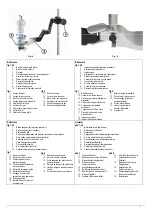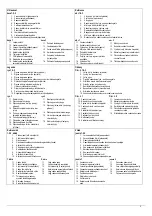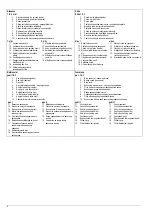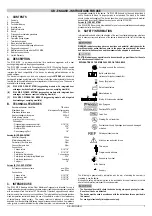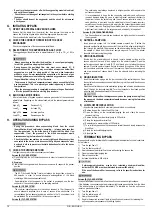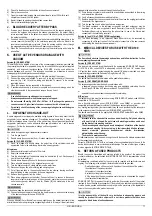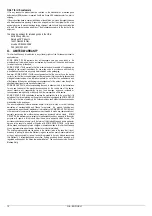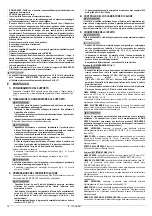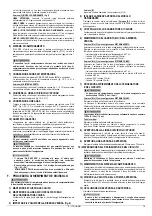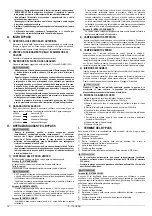
GB - ENGLISH
9
Version [C], OXYGENATING MODULE (fig. 3)
ARTERIAL LINE:
remove the red cap on the oxygenator arterial outlet (ref. 2) in
order to connect a
3/16" line.
PUMP LINE:
the pump loop should be connected between the venous reservoir
outlet connector and the oxygenator venous inlet connector (ref.1) always paying
attention to the direction of rotation of main the pump.
OXYGENATING MODULE PURGE/RECIRCULATION LINE:
remove the
protective cap and connect the male luer end (ref. 7) to a
female luer filtered inlet
on the cardiotomy section of the venous reservoir.
VENOUS SAMPLING LINE:
remove the protective cap and connect the male luer
end of the venous sampling line to the venous sampling luer site on the reservoir
used in combination.
6) SAMPLING SYSTEM
D100 KIDS is supplied with a
pre-connected sampling system. The sampling
system must be fixed to the appropriate holder (D 712). The sampling lines allow
the sampling manifold to be positioned in the range of approximately 1 metre.
The arterial sampling luer connector does not include a
one way valve.
Verify that there is a
one way valve in the sampling line to prevent
accidental air introduction into the arterial line.
7) CONNECT THE TEMPERATURE PROBES
Use SORIN GROUP temperature probes or equivalent ones.
The connection for the arterial temperature probe (fig. 1-2-3, ref. 5) is located next
to the arterial outlet.
Version [A], OPEN SYSTEM:
the venous probe site (fig. 1, ref. 14) is located on the venous inlet connector of
the reservoir.
8) CLOSE THE PURGING/RECIRCULATION LINE
Close the clamp positioned on the purging/recirculation line(fig. 1-2-3, ref. 7)
between oxygenating module and venous reservoir prior to priming.
9) CONNECTING THE GAS LINE
Remove the green cap from the gas inlet connector indicated as “GAS INLET” (fig. 1-
2-3, ref. 3) and connect the 1/4" gas line. Ensure that the gas supply is from
a
suitable air/oxygen mixer such as the Sechrist, (available from SORIN GROUP)
or a
system with compatible technical features. A capnograph can be connected
to the “GAS ESCAPE” connector (fig. 1-2-3, ref. 4).
10) VAPOROUS ANAESTHESTICS
The oxygenator is suitable for use with volatile anaesthetic isoflurane and
sevoflurane, by mean of a
suitable narcosis gas evaporator.
If these vaporous anaesthetics are used, some method of scavenging the gas
from the oxygenator should be considered.
The protocol, the concentration and the monitoring of the anaesthetic gases
administered to the patient, is under the sole responsibility of the physician in
charge of the treatment.
The only volatile anaesthetics suitable for this use are isofluorane and
sevolfuorane
The methods adopted for vaporous anaesthetic gas scavenging should not
increase or reduce in any way the pressure level within the oxygenator
fibres.
- The “GAS ESCAPE” system is designed to avoid any possible risk of
blocking the gas outlet; such blockage could cause the immediate
passage of air to the blood compartment.
- Do not for any reason occlude the external access holes of gas
compartment (fig.
1-2-3, ref. 4).
-
SORIN GROUP ITALIA recommends the use of a
bubble trap or filter on
the arterial line to reduce the risk of emboli transmission to the patient.
F. PRIMING AND RECIRCULATION PROCEDURE
Do not use alcoholic priming solutions: such solutions could compromise
the proper functioning of the oxygenating module.
1) KEEP THE GAS FLOW OFF
2) KEEP THE OXYGENATOR RECIRCULATION/PURGE LINE
CLOSED
Check that the clamp, placed on the oxygenator recirculation/purge line, is
closed.
3) SET THE VOLUME OF THE VENOUS RESERVOIR (fig. 2)
Version [B], only
Set the desired volume using the soft reservoir squeezer (ref. 16).
4) ISOLATE THE VENOUS RESERVOIR FROM THE
OXYGENATING MODULE
Clamp the cardiotomy outlet line (
Version [B] only)
, the venous return line, the
venous reservoir outlet line, and the arterial outlet line of the oxygenator.
5) CHECK THE HEAT EXCHANGER
Verify again the integrity of the heat exchanger, with particular attention to
possible water leaks.
6) VENOUS RESERVOIR/ CARDIOTOMY PRIMING
Version [A] and [C] if in OPEN SYSTEM configuration
Secure with safety ties all suction lines connected to the venous reservoir. Prime
the venous reservoir with sufficient fluid to ensure the intended haematocrit is
obtained, taking into account:
-
the static priming volume of the oxygenator is 31 ml;
-
the 3/16" tubing volume capacity is 19 ml/m;
-
the 1/4" tubing volume capacity is 32 ml/m.
Version [B] and [C] if in CLOSED SYSTEM configuration
Secure with safety ties all suction lines connected to the cardiotomy. Prime the
cardiotomy with sufficient fluid to ensure the intended haematocrit is obtained,
taking into account:
-
the static priming volume of the oxygenator is 31 ml;
-
integrated soft venous reservoir capacity varies from minimum 25 to maximum
90
ml;
-
the 3/16" tubing volume capacity is 19 ml/m;
-
the 1/4" tubing volume capacity is 32 ml/m.
7) OXYGENATOR AND CIRCUIT PRIMING PROCEDURE
The pressure level inside the blood compartment of the oxygenating module
shall not exceed 100 Kpa (1 bar / 14 psi).
Version [B] and [C] if in CLOSED SYSTEM configuration
Remove the clamp from the cardiotomy outlet line.
The priming solution flows to the soft venous reservoir. The air contained inside
the soft venous reservoir will automatically be evacuated from the purge line which
is placed at the top of the reservoir by activating the suction pump.
The pressure level inside the soft venous reservoir shall not exceed 13 KPa
(0.13 bar / 1.9 psi).
All versions
Remove the clamp at the venous reservoir outlet.
Switch the arterial pump on to prime the oxygenating module. Maximum flow shall
not exceed 100 ml/min.
8) OPEN THE PURGING/ RECIRCULATION LINE
When the oxygenator is half primed , open the clamp on the purging/ recirculation
line, and complete the priming of the oxygenating module. In this condition blood
recirculates from the module to the venous reservoir.
9) OPEN VENOUS AND ARTERIAL LINE
Remove the clamp from venous and arterial line
and increase flow up to 700
ml/min.
10) OXYGENATOR AND CIRCUIT DEBUBBLING
During this phase it is necessary to tap the oxygenator and the entire circuit in
order to facilitate the removal of microbubbles from the whole extracorporeal
system.
Maximum blood flow must be maintained at least for 5 minutes to assure
that all air will be removed.
11) PRIME OF THE SAMPLING SYSTEM
Priming of the A/V sampling system occurs automatically when the arterial,
venous and central stopcock handles are positioned towards the access ports of
the manifold to allow the prime to flow from the arterial outlet to the venous
reservoir.
12) REDUCE ARTERIAL FLOW
After complete removal of air from the circuit, it is possible to reduce the arterial
flow to 200 ml/min to recirculate through the opened purging/recirculation line.
13) CLAMP THE VENOUS AND ARTERIAL LINES
Clamp the venous and arterial lines.
- During the priming and debubbling phases, the arterial/venous circuit
must be maintained at least 30 cm higher than the arterial outlet of the
oxygenator.
- Do not use pulsatile flow during priming and debubbling.
- SORIN GROUP ITALIA recommends the use of the pump speed control to
reduce or stop the arterial flow slowly.
- Do not use the pump on/off switch until the pump speed is zero.
Summary of Contents for KIDS D100
Page 2: ...2 Fig 1 Fig 3 Fig 2 ...



